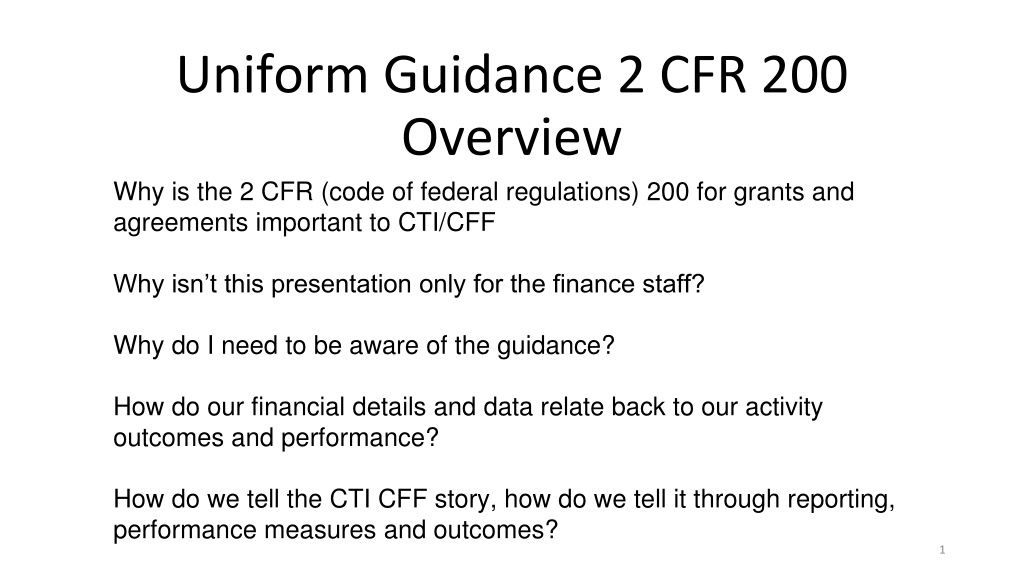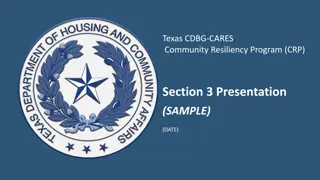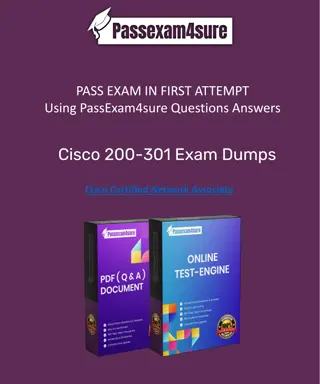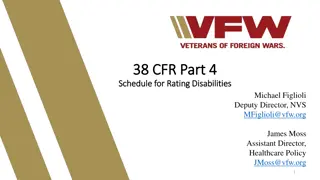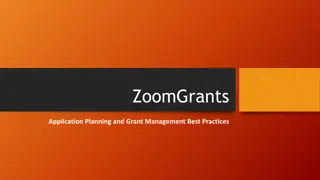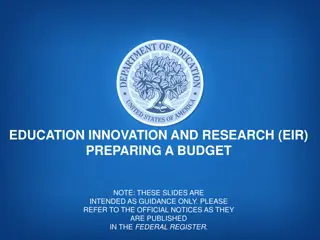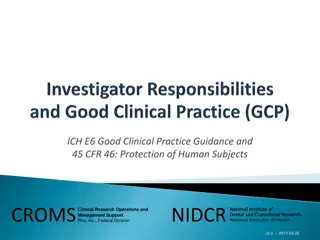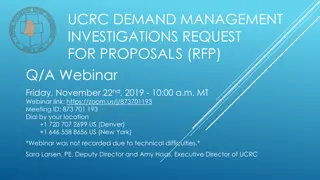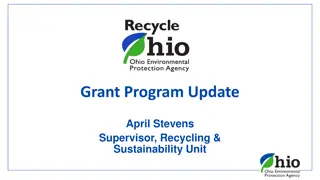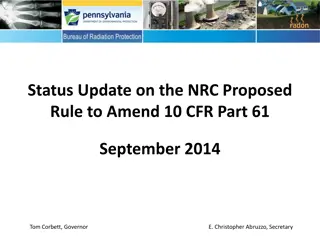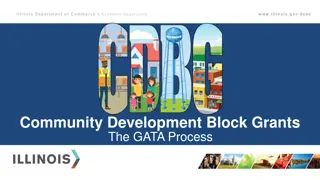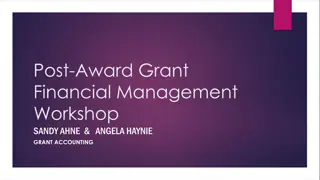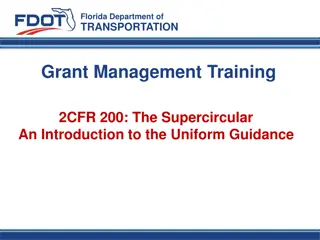Understanding the Importance of 2 CFR 200 for Effective Grant Management
The 2 CFR 200, also known as Uniform Guidance, is crucial for CTI/CFF as it sets out rules for managing Federal awards efficiently, reducing administrative burdens, and preventing fund misuse. It guides audits, financial reporting, cost guidelines, and performance measures. Awareness of this guidance is essential beyond finance staff as it links financial data to program outcomes and storytelling. Compliance ensures effective financial management, internal controls, and performance measurement.
Download Presentation

Please find below an Image/Link to download the presentation.
The content on the website is provided AS IS for your information and personal use only. It may not be sold, licensed, or shared on other websites without obtaining consent from the author. Download presentation by click this link. If you encounter any issues during the download, it is possible that the publisher has removed the file from their server.
E N D
Presentation Transcript
Uniform Guidance 2 CFR 200 Overview Why is the 2 CFR (code of federal regulations) 200 for grants and agreements important to CTI/CFF Why isn t this presentation only for the finance staff? Why do I need to be aware of the guidance? How do our financial details and data relate back to our activity outcomes and performance? How do we tell the CTI CFF story, how do we tell it through reporting, performance measures and outcomes? 1
What is 2 CFR 200? PART 200 UNIFORM ADMINISTRATIVE REQUIREMENTS, COST PRINCIPLES, AND AUDIT REQUIREMENTS FOR FEDERAL AWARDS The Office of Management and Budget's (OMB) Uniform Administrative Requirements, Cost Principles, and Audit Requirements for Federal Awards (commonly called "Uniform Guidance") was officially implemented in December 2014. The Uniform Guidance a "government-wide framework for grants management" is an authoritative set of rules and requirements for Federal awards. The reforms that comprise the Uniform Guidance aim to reduce the administrative burden on award recipients and, at the same time, guard against the risk of waste and misuse of Federal funds. 2 CFR 200 directs the focus of audits on areas that have standardize the processing of data; Clarifies and updates cost reporting guidelines for award recipients. been identified as at risk for waste, fraud and abuse; Lays the groundwork for Federal agencies to 2
Overview of Financial Program Management- Where to find the policies *Statutory and Policy Requirements 200.300 *Performance Measures 200.301 *Financial Management 200.302 *Internal Controls 200.303 *Cost Share/Matching (if applicable) 200.306 *Revision of Budget and Program Plans 200.308. 3
Performance Measurement 2 CFR 200.301 Non Federal Entities must: *Relate Financial Data to Performance *Show Cost Effective Data *Measure Performance Federal Awarding Entities must: *Communicate Expectations *Provide Clear Goals *Analyze and Apply Data 4
Internal Controls 200.303 *Establish and maintain effective internal control over the Federal Award. *Reasonable assurance that the NFE is managing the award in compliance with 2 CFR 200, and the terms and conditions of the award. *Safeguard PII (Personally Identifiable Information) 5
Financial Management Systems 2 CFR 200.302 *Identify Funding Sources- track the funding *Accurate and Current *Identify Expended Funds *Effective Internal Controls *Budget Comparisons to Inputs and Outcomes *Compliance with Payment Requirements *Determine Cost Allowability 6
Revisions of Budget and Program Plans *Change in Scope *Change in Key Personnel *Project Disengagement *Costs that Require Pre-Approval *Contracting/Sub Awarding *Changes to Cost Share (if applicable) 7
Questions: 1. Identify the section of the uniform guidance that details the requirements of a recipient financial management system 2. Identify two responsibilities listed in the Uniform Guidance for both agencies and recipients for using performance measures. 8
Activity: Go to the ecfr website by searching for 2 CFR, Part 200 - https://www.ecfr.gov/cgi-bin/text- idx?tpl=/ecfrbrowse/Title02/2cfr200_main_02.tpl What section of the 2 CFR 200 can an CTI find General Provisions for Selected Cost Give 3 examples of allowable costs that are related to CTI expenditures. 9
Resources. MCI manual lesson 5 (printed and electronic for participants) 2 CFR 200 (ecfr link) https://www.ecfr.gov/cgi-bin/text- idx?tpl=/ecfrbrowse/Title02/2cfr200_main_02.tpl 10
Break time! 11
Defining Performance measures Performance measurement in the grants life cycle 12
Example: Federal Awardee Performance and Integrity Information System (FAIPIS) Applicable to all grant awards in 2016 Contains information relating to NFE past performance Designed to strengthen accountability of NFE s in administering federal grant awards Let s check CTI-CFF! https://www.fapiis.gov/fapiis/index.action 13
Updated Theory of Change Diagram Interventions are the specific set of activities that the project will include to meet the established goals. This is a backwards-working design in which the outcome is established first and the process to achieve the outcome is then developed. Developing a project with the end in mind is beneficial in ensuring the goals will be met. What are some CTI CFf examples of Problem/Intervention and then intended result? 16
Lets enter a quick logic model for a CTI/CFF problem/issue! 20 mins Break into small groups, use the logic model example to review the Input, Output, Outcome impact of a current situation Questions to ponder Be creative, its just practice! *A logic model explains what is invested, what is done and the intended result. Any example can be used *A logic model can be beneficial to the organization in developing a project design and evaluating performance (outcomes) *Your group can use any example, this is a way of thinking planning, evaluation and implementation 18
Another example tempaate: Defining Measures with Logic Models GAO Model 19
Mission Statements Do your programs support your mission statement or vision for the organization? What is CTI-CFF Mission statement? http://www.coraltriangleinitiative.org/history-cti-cff Let s see if the mission statement meets this criteria! Use language that is easily conveys a purpose Explain why the organization exists Be concise Be actionable Be specific Align with the organization priorities 20
Goals Goals outline what the entity wants the project to accomplish. Goals are more detailed than mission statements. While missions describe the purpose of the organization, goals provide actionable items. Goals should be identified in the logic model to verify that the project's activities are aligned with the overall purpose of the organization. 21
Objectives Objectives are measurable targets of a project's goals. Objectives describe the extent of a project's expected results in a given time period. Objectives are used to evaluate if a project has achieved its goals. Well written objectives follow the SMART method. The following figure details the SMART method of writing objectives. 22
Inputs Inputs Vary depending on the nature of the project/task. Some common inputs include: *Funding amounts -Identify existing resources that will be used for the project -Identify additional resources resulting from project funding *Time and level of effort *Employees, and volunteers *Materials, equipment, technology, space and supplies used *Expertise, research, and increase of knowledge base *Partners, consultants, and community relationships 24
Activities can include: *Developing products, such as brochures and training materials that ultimately benefit the public. *Providing services such as training or counseling. *Building infrastructure that benefits the public *Engagement, such as community outreach projects or fostering relationships. 25
Defining and understanding Outputs and Outcomes OUTPUTS OUTCOME Number of training sessions conducted Decreased use of tobacco by teenagers Number of individuals receiving a vaccination Reduced related absenteesism pH Level of river after cleanup activities Improved river ecosystem Number of client referrals Enhanced quality of life for clients Number of police officers hired Improved feeling of safety of residents in their community Group: CTI-CFF Output Group: CTI-CFF Outcome Group: CTI-CFF Output Group: CTI-CFF Outcome 26
Performance measures Are Results oriented Relevant to program mission Responsive Valid Reliable Accessible (Can the organization deliver on their plans?) Comparable Clear 27
WHY? Performance Management in Non-profits translates a mission into reality and evaluates the results to all stakeholders Strategic Level Measure Progress on Issues Define & Validate Policy Strategies Enhance Stakeholder Satisfaction and Support Operational Level Drive Change to Implement Organizational Strategies Ensure Compliance Achieve Efficiencies Improve Cycle Time Individual Level Improved Morale/Retention Achieve Clarity of Responsibilities Transparency of Performance to: *Donors *Elected Leaders *Senior Management *Oversight Entities *Employees *Customers *Partners 28
Break time? 29
Post Award requirements for Non-Federal Entities Relating Financial data to performance when required Providing cost information, such as unit cost data when required Complying with the terms and conditions of the award by meeting performance goals, indicators, and milestones Complying with reporting requirements, and submitting reports in a timely manner Take a quick look at: 200.328 Monitoring and reporting program performance. -Subpart D Post Federal Award Requirements 30
Performance Reporting Requirements 2 CFR 200.328 Frequency determined by federal awarding agency (CTI-CFF is quarterly) Compare actual project performance to targeted performance Detail why targets were not met Explain cost overruns and high unit costs (this could include cost per trainee, or cost per workshop, or travel) 31
Relating Financial Data to Performance Accomplishments 2 CFR 200 requires non-federal entities to: *Relate financial data to performance accomplishments *Provide cost information to demonstrate cost effective practices 32
Internal Controls for Performance Measurement Systems 2 CFR 200.303 Effective and efficient operations Reliable reporting Compliance with applicable laws and regulations 33
Establishing and Maintaining the Internal Control Environment Organizational climate Oversight (checks and balances, reassessing program results) Commitment to competence Accountability 34
Understanding Direct vs. Indirect costs 2 CFR 200 Subpart E (basic criteria for all costs) Allowable costs must be: Reasonable and necessary Permissible under the project Allocable to the project Consistently treated as either direct or indirect Not included as a cost or a cost match for another federal program https://www.ecfr.gov/cgi-bin/text-idx?node=2:1.1.2.2.1.5&rgn=div6 35
Direct Costs: Are those that can be readily designated as benefitting one particular federally funded project or activity. Examples include salaries and wages of staff working directly on a federally funded project and unique supplies or equipment purchased specifically for use on a particular grant project. Indirect costs (10% de minimus rate) Are those that are not easily assigned to a particular project but which are necessary to the operation of the grantee and the performance of the project. Typical indirect costs include, for example salaries or wages of administrative staff, building maintenance and utilities, and basic office supplies that can t be counted toward a program (how many times did Joe use that pen toward the federal grant?! ) 36
A direct cost is any cost that can be specifically identified with a particular project, program, or activity or that can be directly assigned to such activities relatively easily and with a high degree of accuracy. Direct costs include, but are not limited to, salaries, travel, equipment, and supplies directly benefiting the grant-supported project or activity. Most organizations also incur costs for common or joint objectives that cannot be readily identified with an individual project, program, or organizational activity. Facilities operation and maintenance costs, depreciation, and administrative expenses are examples of costs that usually are treated as F&A costs. 37
10% De Minimis Rate 10% De Minimis Rate 2CFR 200.414 (f) In addition to the procedures outlined in the appendices in paragraph (e) of this section, any non-Federal entity that has never received a negotiated indirect cost rate, except for those non-Federal entities described in Appendix VII to Part 200 States and Local Government and Indian Tribe Indirect Cost Proposals, paragraph D.1.b, may elect to charge a de minimis rate of 10% of modified total direct costs (MTDC) which may be used indefinitely. As described in 200.403 Factors affecting allowability of costs, costs must be consistently charged as either indirect or direct costs, but may not be double charged or inconsistently charged as both. If chosen, this methodology once elected must be used consistently for all Federal awards until such time as a non-Federal entity chooses to negotiate for a rate, which the non-Federal entity may apply to do at any time. * If a cost can be designated as benefitting one particular federally funded project, charge it as direct. The direct or indirect must be consistently charged and may not be double charged or inconsistently charged as both. 38
Business Management Systems Personnel Systems and considerations *Position descriptions: Individual personnel file for each employee *Recruiting and hiring: Should be formalized and consistent *Compensation: Salary schedule for all employees *Fringe benefits: Benefits should be reasonable and consistently applied *Consultants: Written policies regarding consultants, and distinguish between consultants and in-house employees 39
Personnel systems continued Fringe Benefits Typical are paid holidays, paid vacation, unpaid leave insurance should be equitable across organization. Termination Dismissal and termination processes 40
Procurement systems 200.317 and 200.326 Standards for procurement are broad. Primary focus is to ensure that recipients have adequate internal controls over procurement. The federal standards for procurement are detailed in 2 CFR 200.317 through 2 CFR 200.326 Let s look that up! https://www.ecfr.gov/cgi-bin/text- idx?node=2:1.1.2.2.1.4.31&rgn=div7 Discuss! 41
Procurement cont Code of conduct- Written and implemented policies regarding acceptable practices, conflicts of interest, or standards of ethical or moral behavior for making procurement (buying) Competition- Official written policy should promote and verify that procurements provide for full and open competition Procurement Procedures- Work with trusted vendors (not suspended or debarred) buy local when possible Cost and Price Analysis- Document market research (best value for the $!) Policies should identify how to document and who is responsible. 42
Procurement continued Procurement Records- Written policy for documenting procurement actions and history. Under 2 CFR 200.333 Records retention is 3 years from date of final expenditure report. Contract Administration- Ensure contractors meet the terms and conditions of the contract and evaluate contractor performance. 43
Property Management Systems Does CTI-CFF purchase property with federal funding? Will you in the future? Here is the guidance: 2 CFR 200.310 through 200.316 Equipment should be adequately safeguarded and maintained and disposition should comply with federal requirements. Equipment Records Insurance Inventory and control requirements Maintenance records Disposition procedures 44
TRAVEL Procedures Authorization and approval Centralized reservations Advances / reimbursements Credit and debit cards Documentation Special circumstances 45
Travel Cost principles General travel costs - 2 CFR 200.274 Dependent care costs 2 CFR 200.474 (c) Travel for dependents is unallowable Airfare costs 2 CFR 474 (d) Customary standard, coach, or equivalent, reasonable Recruiting costs 2 CFR 200.463 46
